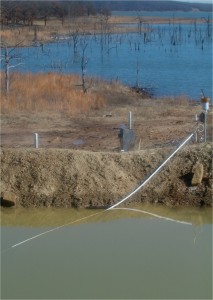USGS Science Featured in a Special Issue of Applied Geochemistry on Contamination from Oil Production
 Pumping oil and gas out of the ground also produces large volumes of water with undesirable quality known as produced water. Spills, leaks, and the improper disposal of produced water can cause severe scarring of the surrounding environment. USGS scientists have installed monitoring equipment (wells, rain gage, sampling line) to collect water-quality data on a salt scar that extends from a brine pit (pit and berm in foreground) to Skiatook Lake, Okla. (in background) at an active oil production site (Site B). A multidisciplinary team of scientists is developing methods to assess salt scars, such as this one.
Pumping oil and gas out of the ground also produces large volumes of water with undesirable quality known as produced water. Spills, leaks, and the improper disposal of produced water can cause severe scarring of the surrounding environment. USGS scientists have installed monitoring equipment (wells, rain gage, sampling line) to collect water-quality data on a salt scar that extends from a brine pit (pit and berm in foreground) to Skiatook Lake, Okla. (in background) at an active oil production site (Site B). A multidisciplinary team of scientists is developing methods to assess salt scars, such as this one.
(Click on photo for larger version) |
|
Results of the U.S. Geological Survey's studies at the Osage-Skiatook Petroleum Environmental Research (OSPER) Project, Oklahoma are featured in a special issue of Applied Geochemistry (Volume 22, Issue 10, October 2007) on environmental issues related to oil and gas exploration and production. Information on the past and present impacts to soil, streams, ground water, and ecosystems caused by exploration and production of oil and gas and coal-bed methane are discussed in the issue. Also presented, is information on the fate and effects of the improper disposal of produced water on near-surface environments. Produced water is highly saline water that is co-produced with oil and gas. Six of the papers in the issue report on results from the OSPER Project. The papers discuss:
- The precipitation of barite in ground water and its role in the occurrence and mobility of two radioactive isotopes of radium (226Ra and 228Ra) present in produced water (Zielinski and Budahn).
- The geological factors that control the surface and subsurface transport of produced-water contamination (Otton and others).
- A 3-dimensional computer model that simulated the evolution of a plume of highly saline water with chemical characteristics similar to the source of produced water in the study area (Herkelrath and others).
- The occurrence and extent of ground water contaminated with produced water from spills and leaks at an active oil-producing site on the shores of Skatook Lake, Okla. (Kharaka and others).
- The chemistry of water in sediments at an old brine storage pit that is now submerged, and the pit's impact on the water-quality of Skiatook Lake (Zielinski and others).
- Using geographic information systems (GIS) to estimate the daily load of salt that Skiatook Lake receives from its 19 tributary streams and approximately 6,700 active and abandoned oil wells in the lake's watershed (Rice and others).
The information presented in this issue can help resource and land managers assess the impacts of historical oil and gas production, and design effective programs to cleanup contamination from the environmental release of produced water. The OSPER Project is a joint activity of the USGS's Toxic Substances Hydrology Program and the Energy Resources Program, along with their partners.
The 12 reports in this issue resulted from presentations given during a special session on "Environmental Issues Related to Oil and Gas Exploration and Production " at the Geological Society of America Annual Meeting held October 16–19, 2005, in Salt Lake City, Utah.
OSPER Papers
- Preface--Environmental issues related to oil and gas exploration and production, by Kharaka, Y.K., and Otton, J.K., p. 2,095-2,098.
- Mode of occurrence and environmental mobility of oil-field radioactive material at US Geological Survey Research Site B, Osage-Skiatook Project, Northeastern Oklahoma, by Zielinski, R.A., and Budahn, J.R., p. 2,125-2,137.
- Geologic controls on movement of produced-water releases at U.S. Geological Survey Research Site A, Skiatook Lake, Osage County, Oklahoma, by Otton, J.K., Zielinski, R.A., Smith, B.D., and Abbott, M.M., p. 2,138-2,154.
- Hydrology and subsurface transport of oil-field brine at the U.S. Geological Survey OSPER Site "A", Osage County, Oklahoma, by Herkelrath, W.N., Kharaka, Y.K., Thordsen, J.J., and Abbott, M.M., p. 2,155-2,163.
- Fate and groundwater impacts of produced water releases at OSPER "B" site, Osage County, Oklahoma, by Kharaka, Y.K., Kakouros, E., Thordsen, J.J., Ambats, G., and Abbott, M.M., p. 2,164-2,176.
- Composition of pore water in lake sediments, research site "B", Osage County, Oklahoma--Implications for lake water quality and benthic organisms, by Zielinski, R.A., Herkelrath, W.N., and Otton, J.K., p. 2,177-2,192.
- Use of dissolved chloride concentrations in tributary streams to support geospatial estimates of Cl contamination potential near Skiatook Lake, Northeastern Oklahoma, by Rice, C.A., Abbott, M.M., and Zielinski, R.A., p. 2,193-2,206.
More Information
Related Headlines
Back to Headlines page
|

|